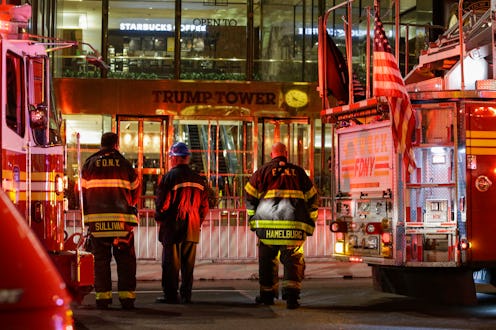News
That Trump Tower Fire's Sparking Calls For A Safety Law The President Once Opposed

On April 7, a deadly fire ripped through the 50th floor of Trump Tower in New York City, killing one resident. Now, a source from the New York City Fire Department has shared a Trump tower fire update that may make you wonder whether this death could have been prevented. According to CNN, the source revealed that there was no working smoke detector in the residential unit and no sprinklers, which made the blaze difficult to combat. There was, however, a building-wide alarm system that initially alerted officials to the fire.
The fire occurred on Saturday on the 50th floor of the building, killing longtime resident, 67-year-old Todd Brassner, and injuring six firefighters. Brassner had owned and lived in the apartment since 1996. According to CNN, the fire was contained to the 50th floor and was completely extinguished around two hours after it first began.
As NBC News described, a senior New York City Fire Department official told the outlet that Brassner's apartment did not have a working smoke alarm or a sprinkler system. According to the New York City Department of Housing Preservation and Development, landlords are required to install smoke detectors in each apartment and tenets are responsible for maintaining them.
As NBC 4 New York described, Trump Tower was constructed in 1983 — prior to the passage of laws mandating sprinkler systems in high rise residential units. As the outlet noted, the law was eventually changed to mandate that owners of older high rises install sprinklers in residential areas, but only if the building is undergoing significant renovation. Thus, Trump Tower has been exempt from the residential sprinkler requirement.
President Trump has not commented on the lack of sprinkler systems in Trump Tower following the fire on April 7. He did, however, briefly reflect on the building's construction on Twitter and thanked firefighters. As the president wrote, "Fire at Trump Tower is out. Very confined (well built building). Firemen (and women) did a great job. THANK YOU!"
The Washington Post reported that, as a real estate developer in New York City, Trump once heavily advocated against the installation of sprinkler systems in residential units of high rises. Dan Barry and Michael Cooper of the New York Times reported on the topic in December of 1998. The journalists noted that Archie Spigner, the then-chairman of the City Council's Housing and Buildings Committee, said that he had received a call from Trump at the time expressing "concern about the high cost of installation and other problems that he had with sprinklers." Trump had also confirmed to the Times that he had ''received and placed calls [about the sprinkler issue]'' from and to several city officials.
In 1999, Trump did decide to install sprinklers in all 350 residential units of his newly-constructed Trump World Tower — which is not the same building in which Saturday's fire occurred. After agreeing to install the Trump World Tower sprinklers in 1999, Trump noted to the New York Times that he did not believe that sprinklers contribute to preventing fire deaths.
“People feel safer with sprinklers,” Trump told the Times. “But the problem with the bill is that it doesn’t address the buildings that need sprinklers the most. If you look at the fire deaths in New York, almost all of them are in one-or two-family houses.”
Following the Trump Tower fire, some officials are calling for a closure to the sprinkler loophole that allows older buildings to skip the residential sprinkler requirement. At a press conference on Monday, Robert E. Cornegy, Jr., the chairman of the City Council committee on buildings, called for legislation to remedy this issue. According to Metro New York, Cornegy told reporters,
This is not about the construction of the building [referring to a tweet the president wrote about Trump Tower's solid composition] ... It may be structurally sound, but in an effort to protect residents, we need more than a passive alarm system. We need a sprinkler system, not just for the Trump building, but for all buildings that are four units and above ... The passive system allowed now, just smoke alarms — we don’t believe is enough. [It’s] not enough to protect lives to the degree the council and my committee believes should be in place.
It certainly seems that some improvements could be made to help prevent future fires in high rise residences. Those in New York will likely be following Cornegy's push for legislation closely, waiting to see if his proposed requirements become a reality.